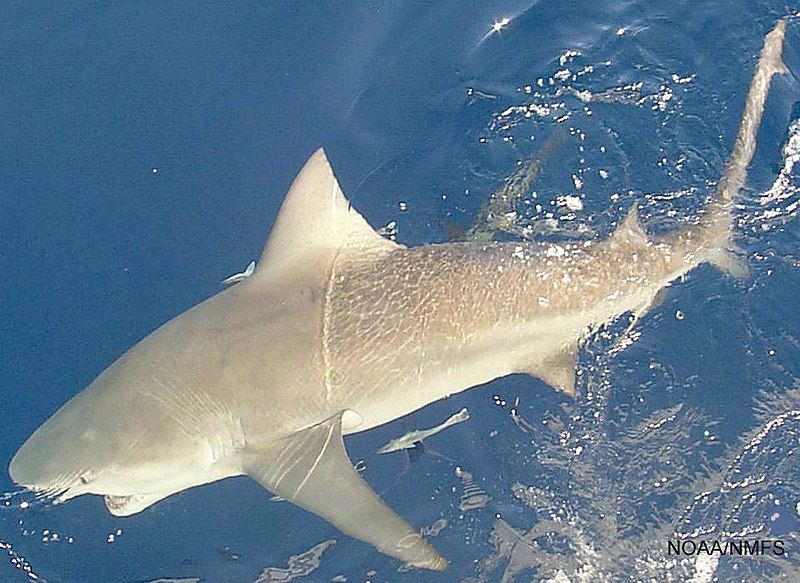To understand the topic of bull sharks’ endangerment, delve into the introduction. Gain insights into the definition of bull sharks and their significance in the ecosystem. Explore why it is crucial to examine the current state of bull shark populations and the potential consequences of their endangerment.
Key takeaways
- Bull sharks are not currently considered endangered, but their population is declining in some areas due to overfishing and habitat loss.
- They are highly adaptable and can survive in both saltwater and freshwater environments, making them more resilient to changes in their habitat.
- Bull sharks are known for their aggressive behavior and are responsible for a significant number of shark attacks on humans.
- Conservation efforts are needed to protect bull sharks and their habitats, including implementing fishing regulations and creating marine protected areas.
- Understanding the behavior and migration patterns of bull sharks is crucial for their conservation and management.
Definition of Bull Sharks

Bull sharks, also known as Carcharhinus leucas, are a truly remarkable species found in oceans around the world. These creatures have many unique features. Most notably, their ability to survive in both saltwater and freshwater.
Bull sharks can grow up to 11 feet long and weigh over 500 pounds. Females tend to be larger than males. They have a stout body, blunt snout, and powerful jaws filled with sharp teeth.
They are known for their aggressive nature and are one of the most dangerous shark species to humans. That’s because they usually inhabit shallow waters near coastlines.
Bull sharks have the unusual ability to regulate buoyancy using an oil-filled liver. This allows them to maintain neutral buoyancy at different depths. They also have excellent senses, including acute vision, sense of smell, and electroreception.
When encountering these formidable creatures, remain calm and avoid sudden movements. Back away slowly without turning your back on the shark. Respect them and admire them from a safe distance!
Significance of Bull Sharks in the Ecosystem
Bull sharks are key players in the marine ecosystem, with their unique adaptations and role as apex predators. They help keep prey populations in check, stopping them from overconsuming. Their ability to live in both saltwater and freshwater environments gives them a global reach. This adaptability makes them important for maintaining aquatic ecosystems.
Furthermore, Bull sharks show behaviors that benefit the environment. They control populations of fish and other sea life, preventing any one species from overpowering the others. By preying on the weak, they promote natural selection and a diverse ecosystem.
These powerful creatures also have exceptional predatory skills. Their strength, speed, and senses let them hunt for prey with ease. This helps control lower trophic levels, which stops overcrowding and keeps the balance.
Bull sharks are essential for conservation efforts, thanks to their role in population control and biodiversity. We must protect them from human threats like overfishing, water pollution, and habitat destruction.
We must recognize their importance for preserving the delicate marine ecosystem. Supporting conservation initiatives and advocating sustainable fishing and habitat protection can ensure future generations get to see these amazing creatures in our waters. We must act now – our oceans depend on it!
Threats to Bull Sharks

To address the threats to bull sharks, explore the sub-sections of overfishing, habitat destruction, and climate change. Each of these factors poses a significant challenge to the survival of bull sharks in their natural habitats. By understanding these issues, we can better comprehend the urgency of protecting these magnificent creatures.
Overfishing
The depletion of shark populations due to overfishing is a major concern. As bull sharks are slow-growing and have low reproductive rates, they can’t replenish their numbers fast enough. This disrupts the ecological balance and can have negative impacts on local economies that rely on healthy marine ecosystems. Plus, overfishing practices can lead to the unintentional capture and killing of non-target species.
We need to act now and join hands with organizations dedicated to preserving our oceans and safeguarding vulnerable species like bull sharks. By implementing sustainable fishing practices, supporting conservation initiatives, and enforcing stricter regulations we can ensure a future where these majestic creatures continue to thrive in their natural habitats. Don’t miss out on being part of this critical mission!
Habitat destruction
Bull sharks are in danger due to habitat destruction. Coastal areas and estuaries are being destroyed, which is bad for these sharks. The development of coastal areas and the loss of mangroves are making it hard for bull sharks to survive.
Pollution is also a huge problem. Industrial waste, agricultural run-off, and urban sewage are contaminating water. This is harmful to bull sharks and is causing their population to decline.
We need to act now to save bull sharks from extinction. We should stop coastal development and control pollution. This will help protect them and help maintain a healthy marine ecosystem.
We must act quickly or else bull sharks will be gone forever. They may be able to survive in extreme conditions, but even they can’t outlast climate change. Let’s do something before it’s too late.
Climate change
Climate change is taking its toll on bull sharks. Rising water temperatures disrupt their habitats and can reduce food availability. Extreme weather events can also cause destruction to their usual coastal areas. Climate change is even altering ocean currents and salinity levels, potentially disrupting their migration and reproduction. Plus, rising sea levels can flood their usual hunting grounds and nurseries.
In one summer off Florida, bull sharks were forced into an unexpected territory due to rising water temperatures. Astonishingly, they adapted quickly to freshwater rivers and the abundance of fish. This story illustrates their resilience but also reminds us that we need to do more to protect them from the effects of climate change.
Current conservation status of Bull Sharks
To understand the current conservation status of Bull Sharks, explore the evaluation of population trends and the identification of endangered species. Dive into the sub-sections that provide solutions for evaluating the population and determining which Bull Shark species are at risk.
Evaluation of population trends Of Bull Sharks
Studying population trends of Bull Sharks is essential to understanding their conservation status. By analyzing data and noticing patterns, researchers can track changes in Bull Shark numbers. In the Gulf of Mexico, 900,000 Bull Sharks are estimated to exist and are classified as Vulnerable. On Australia’s East Coast, 500,000 are Near Threatened.
Habitat loss and overfishing are major causes of Bull Shark’s decline. They inhabit coastal waters, however, human activities along coastlines are destroying their habitats.
In 2008, the International Union for Conservation of Nature (IUCN) Red List assessed Bull Sharks as “Near Threatened” due to significant global population drops.
To protect these creatures and ensure their long-term survival, understanding population trends is crucial. Implementing effective management strategies and raising awareness among coastal communities is necessary to preserve these majestic animals for future generations.
Efforts to protect Bull Sharks
To protect Bull Sharks, conservation organizations and initiatives, fishing regulations and restrictions, and research and monitoring programs have been implemented. These measures aim to safeguard their population and maintain a healthy ecosystem.
Conservation organizations and initiatives
- The Shark Trust focuses on research, education, and advocacy for Bull Sharks and their habitats.
- The Save Our Seas Foundation provides support for scientific research, conservation programs, and public awareness campaigns.
- The IUCN Red List classifies Bull Sharks as “near threatened,” prompting conservation efforts.
- Local initiatives collaborate with fishermen, encouraging sustainable fishing practices to protect Bull Sharks.
- Organizations prioritize strategies for monitoring shark populations and habitats. And, they seek to create protected areas.
- Support these organizations financially or volunteer your time, as every effort counts.
For fishing regulations and restrictions, desperate times call for desperate measures – anglers must use rubber ducks and toy fishing rods to keep Bull Sharks safe.
Fishing regulations and restrictions
Fishing regulations and restrictions involve size limits and catch limits. Plus, no fishing in designated protected areas. Commercial fishing for bull sharks is strictly prohibited too!
When recreational fishing, it’s vital to be aware of local regulations and catch limits to help safeguard bull shark populations. Researching and monitoring bull sharks may not be exciting, but it’s an effective way to prevent them from becoming endangered.
Research and monitoring programs
Research and monitoring programs for bull sharks are essential for their safety and comprehension of their behavior. Data is gathered on population dynamics, migration patterns, and habitat use. Physiological aspects such as reproductive biology and feeding habits are also studied. Researchers gain knowledge of the ecological role of bull sharks and create protective strategies.
A table can show all aspects of the programs:
| Program Name | Focus Area |
|---|---|
| Population | Dynamics |
| Migration | Patterns |
| Habitat Use | Patterns |
| Reproductive | Biology |
| Feeding Habits | Biology |
Human activities impacting bull shark populations are further explored. This includes investigating the effects of pollution, overfishing, and climate change. Understanding these threats helps conservationists to work on reducing them and preserving bull sharks.
Pro Tip: Collaborate with local communities and stakeholders to collect data and promote awareness of bull shark protection. Even though we work hard to protect them, they’ll still be scaring you at the beach!
Conclusion
The population of Bull sharks, a unique species of sharks, has been drastically decreasing due to overfishing and habitat loss. These apex predators are a vital part of marine ecosystems, with their decline having a detrimental effect on the overall health of the oceans and other marine life. Stricter regulations must be implemented by conservation organizations and governments to protect these incredible creatures.
It is essential to recognize that Bull sharks possess the special ability to survive in both saltwater and freshwater habitats. This adaptability makes them essential for keeping the biodiversity of ecosystems alive, where other shark species can’t survive. Therefore, preserving their habitats is necessary for the well-being of not only Bull sharks but also the various marine organisms relying on them.
For those wanting to help, supporting organizations working towards the conservation of Bull sharks through donations or volunteering can make a real difference in safeguarding their future. The success of this endeavor is like that awkward family reunion – we may not want to attend, but we must show up to save the planet.
Frequently Asked Questions
1. What is the current status of the bull shark population?
The bull shark population is considered to be near threatened, but it varies in different regions. In some areas, they are more abundant, while in others their numbers have declined.
2. What are the main factors contributing to the endangerment of bull sharks?
Habitat loss, overfishing, and pollution are the primary factors contributing to the endangerment of bull sharks. These sharks rely on healthy coastal environments, which are increasingly impacted by human activities.
3. Are bull sharks protected by any laws or conservation efforts?
Bull sharks are not specifically protected by international conservation agreements or laws, but they are indirectly safeguarded through regulations on fishing and habitat preservation.
4. What are the risks associated with the decline in the bull shark population?
The decline in the bull shark population can disrupt the marine ecosystem balance. As apex predators, bull sharks play a crucial role in controlling fish populations and maintaining the health of their habitats.
5. Are there any ongoing initiatives to conserve bull sharks?
Yes, there are various ongoing initiatives focused on bull shark conservation. These include efforts to reduce bycatch in fishing operations, the establishment of marine protected areas, and research on their behavior and migration patterns.
6. Can bull sharks adapt and recover from endangerment?
Bull sharks have the potential to adapt and recover from endangerment given the right conservation measures. With adequate habitat protection and fishing regulations, their population can stabilize and even increase over time.
References




